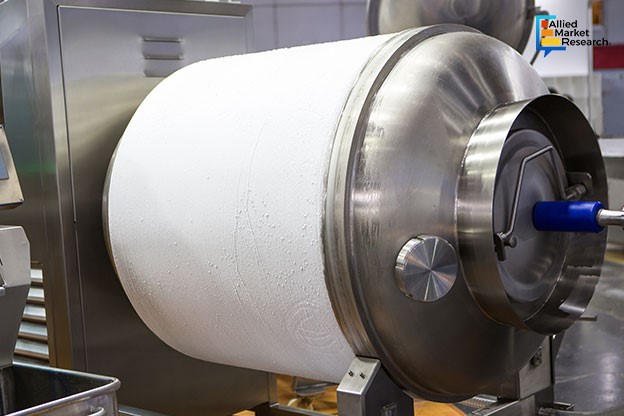Food Vacuum Cleaning Equipment: Increased Packaged Foods Consumption Driving Industry Growth

16 Apr
2025
Key takeaways:
- Introduction
- Advantages of food vacuum cleaning equipment
- Product launches in the industry
Food vacuum cooling is a novel cooling technique generally used for porous food products that have free water. Based on the principles of evaporative cooling, this method is used for processing bakery products, meat, fruits, vegetables, and other such ready-to-eat snacks. Typically, food vacuum cooling equipment features a water ring pump, steam jet, and a heat exchanger, which aid in cooling food products without physically handling them. Over the years, the demand for such innovative machines from the food and beverage companies has increased drastically. The surge in the consumption of packaged food items has compelled businesses to adopt advanced preservation techniques that improve the shelf life of the products significantly. This has boosted the revenue share of the food vacuum cooling equipment market.
Gradual transition toward vacuum cooling processes helping the sector flourish
The food vacuum cooling equipment industry accounted for $814.1 million in 2024 and is predicted to gather a sum of $1,185.8 million by 2034, rising at a CAGR of 3.7% during 2025-2034. Compared to conventional cooling processes, this innovative method can quickly extract heat from the food items without adding any medium in them. Several engineering studies have revealed that currently, vacuum cooling is probably the fastest methodology in the world. The use of these techniques has enabled companies to maximize their efficiency and productivity, thus expanding their footprint in the food packaging sector.
One major problem faced by farmers in developing countries like India is the unavailability of cold storage facilities, which damages their produce during transportation and marketing. In such a scenario, food vacuum cleaning equipment becomes an ideal solution to increase the shelf life of fruits, vegetables, and other such food items that have high water content. This ultimately aids cultivators in storing their yield for a longer period and getting a better price for their produce. Moreover, compared to traditional food cooling machines like blast chillers, this novel method is three times energy efficient and helps reduce electricity consumption. This has further increased their use in food packaging processes as they aid businesses in bringing down their input costs.
Product launches by key businesses generating new growth opportunities
In the last few years, many leading companies have invested in the food vacuum cooling equipment industry and initiated R&D projects to drive innovation and advance technology in the sector. On the other hand, some enterprises have launched innovative machines to strengthen their foothold in the market. For instance, Durrer Spezialmaschinen AG, a mechanical engineering company in Switzerland, announced the launch of a vacuum cooling technology specially designed for bakery products. Developed in collaboration with the Zurich University of Applied Sciences (ZHAW), the product features several sensors and other data collection devices that improve the overall accuracy and efficiency of heat extraction processes.
Similarly, in August 2024, Verhoeven Family of Companies, a Dutch engineering firm, unveiled new upgrades for its vacuum cooling and baking technology. Originally launched in 2020, the product has been developed to cater to the needs of the bakery industry. The press release issued by the company highlighted that since the machine was launched during the pandemic, the company was unable to demonstrate the working of the equipment in Factory Acceptance Tests (FAT) and Site Acceptance Tests (SAT). Recently, Verhoeven announced that the product had satisfactorily passed all the tests and was ready for the integration of advanced technologies like AI and machine learning.
In conclusion, the growth of the food vacuum cooling equipment industry is attributed to the rise in demand for advanced food processing techniques from multinational companies around the globe. Moreover, the different advantages offered by this novel methodology over conventional technologies are expected to open new investment avenues in the market in the near future.
Contact our experts for tips and recommendations on how to capitalize on the opportunities offered by the industry!

Akhilesh Prabhugaonkar
Author's Bio- Akhilesh Prabhugaonkar holds a bachelor’s degree in Electronics Engineering from the reputed Vishwakarma Institute of Technology. He has a special interest in the fields of forensics, world history, international relations and foreign policy, sports, agriculture, astronomy, security, and oceanography. An ardent bibliophile and melophile, Akhilesh loves to write on topics of his interest and various other societal issues. This love for writing made him enter the professional world of content writing and pursue his career in this direction.
Avenue: Entire Library membership of Allied Market Research Reports at your disposal
- Avenue is an innovative subscription-based online report database.
- Avail an online access to the entire library of syndicated reports on more than 2,000 niche industries and company profiles on more than 12,000 firms across 11 domains.
- A cost-effective model tailored for entrepreneurs, investors, and students & researchers at universities.
- Request customizations, suggest new reports, and avail analyst support as per your requirements.
- Get an access to the library of reports at any time from any device and anywhere.
Related Post
-
How are Submarine Cables Transforming Global Connectivity with Enhanced User Experience?
-
Endoscopy Procedures: Transformations in Techniques and Applications
-
AI-Powered Video Analytics: How the Product Actually Works for enterprises
-
Painting Robots: Transforming Precision Coating and Creative Applications
-
Innovations in Pharmacovigilance Systems Advancing Patient Safety
-
Understanding Edge Security: Keeping Data Safe Near the Source
-
Exploring the Use and Advancements of 3D Laser Scanners in Professional Applications
-
Reinforcing Industrial Controls with Smarter Tools and Training








